The thalamus is a large, ovoid structure in the dorsal part of the diencephalon Diencephalon The paired caudal parts of the prosencephalon from which the thalamus; hypothalamus; epithalamus; and subthalamus are derived. Development of the Nervous System and Face that is located between the cerebral cortex Cerebral cortex The cerebral cortex is the largest and most developed part of the human brain and CNS. Occupying the upper part of the cranial cavity, the cerebral cortex has 4 lobes and is divided into 2 hemispheres that are joined centrally by the corpus callosum. Cerebral Cortex: Anatomy and midbrain Midbrain The middle of the three primitive cerebral vesicles of the embryonic brain. Without further subdivision, midbrain develops into a short, constricted portion connecting the pons and the diencephalon. Midbrain contains two major parts, the dorsal tectum mesencephali and the ventral tegmentum mesencephali, housing components of auditory, visual, and other sensorimotor systems. Brain Stem: Anatomy, consisting of several interconnected nuclei of gray matter Gray matter Region of central nervous system that appears darker in color than the other type, white matter. It is composed of neuronal cell bodies; neuropil; glial cells and capillaries but few myelinated nerve fibers. Cerebral Cortex: Anatomy separated by the laminae of white matter White Matter The region of central nervous system that appears lighter in color than the other type, gray matter. It mainly consists of myelinated nerve fibers and contains few neuronal cell bodies or dendrites. Brown-Séquard Syndrome. The thalamus is the main conductor of information that passes between the cerebral cortex Cerebral cortex The cerebral cortex is the largest and most developed part of the human brain and CNS. Occupying the upper part of the cranial cavity, the cerebral cortex has 4 lobes and is divided into 2 hemispheres that are joined centrally by the corpus callosum. Cerebral Cortex: Anatomy and the periphery, spinal cord Spinal cord The spinal cord is the major conduction pathway connecting the brain to the body; it is part of the CNS. In cross section, the spinal cord is divided into an H-shaped area of gray matter (consisting of synapsing neuronal cell bodies) and a surrounding area of white matter (consisting of ascending and descending tracts of myelinated axons). Spinal Cord: Anatomy, or brain Brain The part of central nervous system that is contained within the skull (cranium). Arising from the neural tube, the embryonic brain is comprised of three major parts including prosencephalon (the forebrain); mesencephalon (the midbrain); and rhombencephalon (the hindbrain). The developed brain consists of cerebrum; cerebellum; and other structures in the brain stem. Nervous System: Anatomy, Structure, and Classification stem and is divided into the anterior, medial, and lateral parts. Each part contains groups of nuclei that function as relay centers for sensory Sensory Neurons which conduct nerve impulses to the central nervous system. Nervous System: Histology impulses and for the modulation of motor Motor Neurons which send impulses peripherally to activate muscles or secretory cells. Nervous System: Histology responses via interconnections with the basal ganglia Basal Ganglia Basal ganglia are a group of subcortical nuclear agglomerations involved in movement, and are located deep to the cerebral hemispheres. Basal ganglia include the striatum (caudate nucleus and putamen), globus pallidus, substantia nigra, and subthalamic nucleus. Basal Ganglia: Anatomy.
Last updated: Dec 15, 2025
| Nucleus Nucleus Within a eukaryotic cell, a membrane-limited body which contains chromosomes and one or more nucleoli (cell nucleolus). The nuclear membrane consists of a double unit-type membrane which is perforated by a number of pores; the outermost membrane is continuous with the endoplasmic reticulum. A cell may contain more than one nucleus. The Cell: Organelles | Major input | Major output | Function |
|---|---|---|---|
| Anterior | Mammillary body and hippocampal formation Hippocampal formation A curved elevation of gray matter extending the entire length of the floor of the temporal horn of the lateral ventricle. The hippocampus proper, subiculum, and dentate gyrus constitute the hippocampal formation. Sometimes authors include the entorhinal cortex in the hippocampal formation. Limbic System: Anatomy | Cingulate gyrus Cingulate gyrus One of the convolutions on the medial surface of the cerebral hemispheres. It surrounds the rostral part of the brain and corpus callosum and forms part of the limbic system. Limbic System: Anatomy | Limbic pathway |
| Ventral posteromedial | Trigeminothalamic tract and rostral solitary nucleus Nucleus Within a eukaryotic cell, a membrane-limited body which contains chromosomes and one or more nucleoli (cell nucleolus). The nuclear membrane consists of a double unit-type membrane which is perforated by a number of pores; the outermost membrane is continuous with the endoplasmic reticulum. A cell may contain more than one nucleus. The Cell: Organelles | Primary somatosensory cortex Somatosensory cortex Area of the parietal lobe concerned with receiving sensations such as movement, pain, pressure, position, temperature, touch, and vibration. It lies posterior to the central sulcus. Cerebral Cortex: Anatomy and gustatory cortex | Touch, position, pain Pain An unpleasant sensation induced by noxious stimuli which are detected by nerve endings of nociceptive neurons. Pain: Types and Pathways, and temperature from face; taste |
| Ventral posterolateral | Dorsal column-medial lemniscus and anterolateral tract | Primary somatosensory cortex Somatosensory cortex Area of the parietal lobe concerned with receiving sensations such as movement, pain, pressure, position, temperature, touch, and vibration. It lies posterior to the central sulcus. Cerebral Cortex: Anatomy | Sense of pain Pain An unpleasant sensation induced by noxious stimuli which are detected by nerve endings of nociceptive neurons. Pain: Types and Pathways and temperature, touch, and position |
| Ventral anterior | Basal ganglia Basal Ganglia Basal ganglia are a group of subcortical nuclear agglomerations involved in movement, and are located deep to the cerebral hemispheres. Basal ganglia include the striatum (caudate nucleus and putamen), globus pallidus, substantia nigra, and subthalamic nucleus. Basal Ganglia: Anatomy | Motor Motor Neurons which send impulses peripherally to activate muscles or secretory cells. Nervous System: Histology, premotor, and diffuse | Motor Motor Neurons which send impulses peripherally to activate muscles or secretory cells. Nervous System: Histology planning |
| Ventral lateral | Cerebellum Cerebellum The cerebellum, Latin for “little brain,” is located in the posterior cranial fossa, dorsal to the pons and midbrain, and its principal role is in the coordination of movements. The cerebellum consists of 3 lobes on either side of its 2 hemispheres and is connected in the middle by the vermis. Cerebellum: Anatomy | Motor Motor Neurons which send impulses peripherally to activate muscles or secretory cells. Nervous System: Histology and premotor cortex | Motor Motor Neurons which send impulses peripherally to activate muscles or secretory cells. Nervous System: Histology planning and control |
| Dorsomedial | Amygdala Amygdala Almond-shaped group of basal nuclei anterior to the inferior horn of the lateral ventricle of the temporal lobe. The amygdala is part of the limbic system. Limbic System: Anatomy, olfactory cortex Olfactory cortex Basal forebrain and medial part of temporal lobe areas that receive synaptic inputs from the olfactory bulb. Olfaction: Anatomy, limbic basal ganglia Basal Ganglia Basal ganglia are a group of subcortical nuclear agglomerations involved in movement, and are located deep to the cerebral hemispheres. Basal ganglia include the striatum (caudate nucleus and putamen), globus pallidus, substantia nigra, and subthalamic nucleus. Basal Ganglia: Anatomy | Frontal Frontal The bone that forms the frontal aspect of the skull. Its flat part forms the forehead, articulating inferiorly with the nasal bone and the cheek bone on each side of the face. Skull: Anatomy cortex | Limbic pathway, major relay to frontal Frontal The bone that forms the frontal aspect of the skull. Its flat part forms the forehead, articulating inferiorly with the nasal bone and the cheek bone on each side of the face. Skull: Anatomy cortex |
| Pulvinar | Visual, auditory, and other sensory pathways Sensory pathways Spinal Cord: Anatomy | Parietal Parietal One of a pair of irregularly shaped quadrilateral bones situated between the frontal bone and occipital bone, which together form the sides of the cranium. Skull: Anatomy, occipital Occipital Part of the back and base of the cranium that encloses the foramen magnum. Skull: Anatomy, and areas of temporal association | Sensory Sensory Neurons which conduct nerve impulses to the central nervous system. Nervous System: Histology integration and visual attention Attention Focusing on certain aspects of current experience to the exclusion of others. It is the act of heeding or taking notice or concentrating. Psychiatric Assessment |
| Medial geniculate | Inferior colliculus Inferior colliculus The posterior pair of the quadrigeminal bodies which contain centers for auditory function. Brain Stem: Anatomy | Primary auditory cortex Auditory cortex The region of the cerebral cortex that receives the auditory radiation from the medial geniculate body. Auditory and Vestibular Pathways: Anatomy | Hearing |
| Lateral geniculate | Retina Retina The ten-layered nervous tissue membrane of the eye. It is continuous with the optic nerve and receives images of external objects and transmits visual impulses to the brain. Its outer surface is in contact with the choroid and the inner surface with the vitreous body. The outermost layer is pigmented, whereas the inner nine layers are transparent. Eye: Anatomy ( optic tract Optic Tract Nerve fiber originating from the optic chiasm that connects predominantly to the lateral geniculate bodies. It is the continuation of the visual pathway that conveys the visual information originally from the retina to the optic chiasm via the optic nerves. The Visual Pathway and Related Disorders) | Primary visual cortex Primary Visual Cortex The Visual Pathway and Related Disorders | Vision Vision Ophthalmic Exam |
| Intralaminar | Reticular formation Reticular Formation A region extending from the pons and medulla oblongata through the mesencephalon, characterized by a diversity of neurons of various sizes and shapes, arranged in different aggregations and enmeshed in a complicated fiber network. Brain Stem: Anatomy, spinal cord Spinal cord The spinal cord is the major conduction pathway connecting the brain to the body; it is part of the CNS. In cross section, the spinal cord is divided into an H-shaped area of gray matter (consisting of synapsing neuronal cell bodies) and a surrounding area of white matter (consisting of ascending and descending tracts of myelinated axons). Spinal Cord: Anatomy, hypothalamus Hypothalamus The hypothalamus is a collection of various nuclei within the diencephalon in the center of the brain. The hypothalamus plays a vital role in endocrine regulation as the primary regulator of the pituitary gland, and it is the major point of integration between the central nervous and endocrine systems. Hypothalamus | Limbic cortex and basal ganglia Basal Ganglia Basal ganglia are a group of subcortical nuclear agglomerations involved in movement, and are located deep to the cerebral hemispheres. Basal ganglia include the striatum (caudate nucleus and putamen), globus pallidus, substantia nigra, and subthalamic nucleus. Basal Ganglia: Anatomy | Arousal, motivation, affect, pain Pain An unpleasant sensation induced by noxious stimuli which are detected by nerve endings of nociceptive neurons. Pain: Types and Pathways |
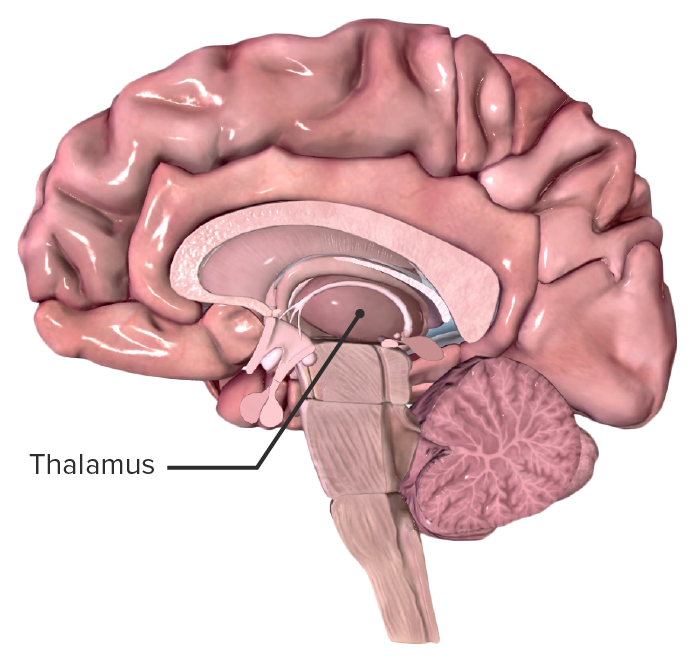
Location of the thalamus in a midsagittal section of the human brain
Image by BioDigital, edited by Lecturio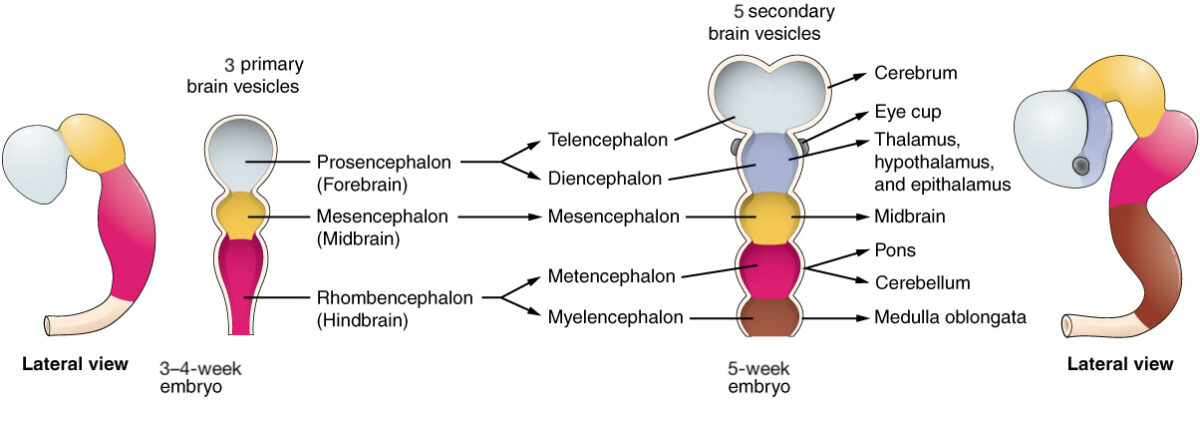
Development of the thalamus from the prosencephalon, where it forms the diencephalon, comprising the thalamus, hypothalamus, and epithalamus
Image: “Primary and Secondary Vesicle Stages of Development ” by Phil Schatz. License: CC BY 4.0, edited by Lecturio.The anterior nuclei are subdivided into 3 sections with inputs from the mammillary bodies Mammillary bodies A pair of nuclei and associated gray matter in the interpeduncular space rostral to the posterior perforated substance in the posterior hypothalamus. Limbic System: Anatomy and hippocampus and output to the cingulate gyrus Cingulate gyrus One of the convolutions on the medial surface of the cerebral hemispheres. It surrounds the rostral part of the brain and corpus callosum and forms part of the limbic system. Limbic System: Anatomy. The anterior nuclei are associated with learning, memory Memory Complex mental function having four distinct phases: (1) memorizing or learning, (2) retention, (3) recall, and (4) recognition. Clinically, it is usually subdivided into immediate, recent, and remote memory. Psychiatric Assessment, and emotion.
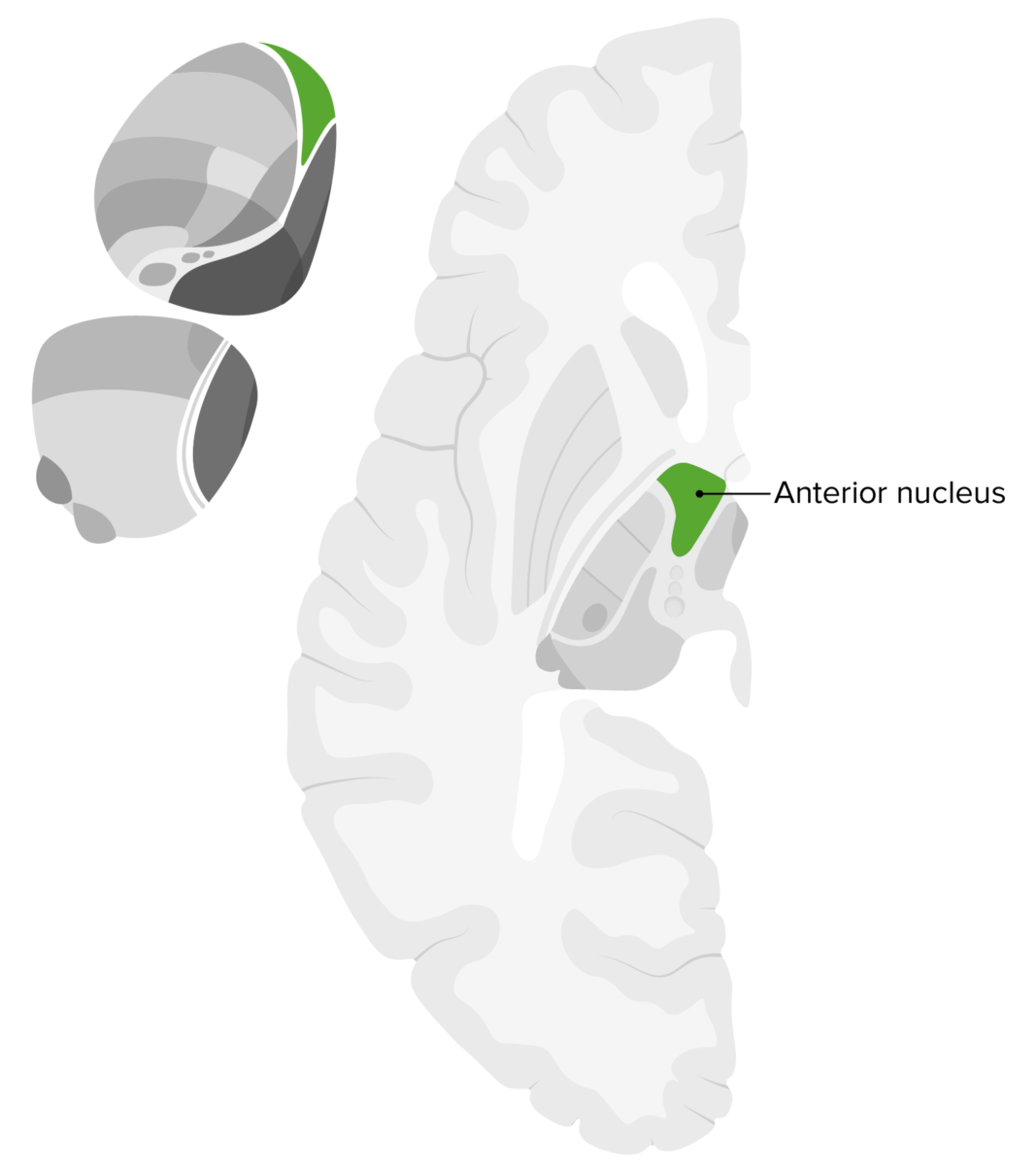
Location of the anterior nucleus within the thalamus: Note its central and anterior location within this hemisection of the brain.
Image by Lecturio.The ventral posteromedial and ventral posterolateral nuclei are associated with inputs from the rostral solitary nucleus Nucleus Within a eukaryotic cell, a membrane-limited body which contains chromosomes and one or more nucleoli (cell nucleolus). The nuclear membrane consists of a double unit-type membrane which is perforated by a number of pores; the outermost membrane is continuous with the endoplasmic reticulum. A cell may contain more than one nucleus. The Cell: Organelles and trigeminothalamic tract and outputs to the primary somatosensory cortex Somatosensory cortex Area of the parietal lobe concerned with receiving sensations such as movement, pain, pressure, position, temperature, touch, and vibration. It lies posterior to the central sulcus. Cerebral Cortex: Anatomy and frontal Frontal The bone that forms the frontal aspect of the skull. Its flat part forms the forehead, articulating inferiorly with the nasal bone and the cheek bone on each side of the face. Skull: Anatomy operculum Operculum Dibothriocephalus/Diphyllobothriasis/insula.
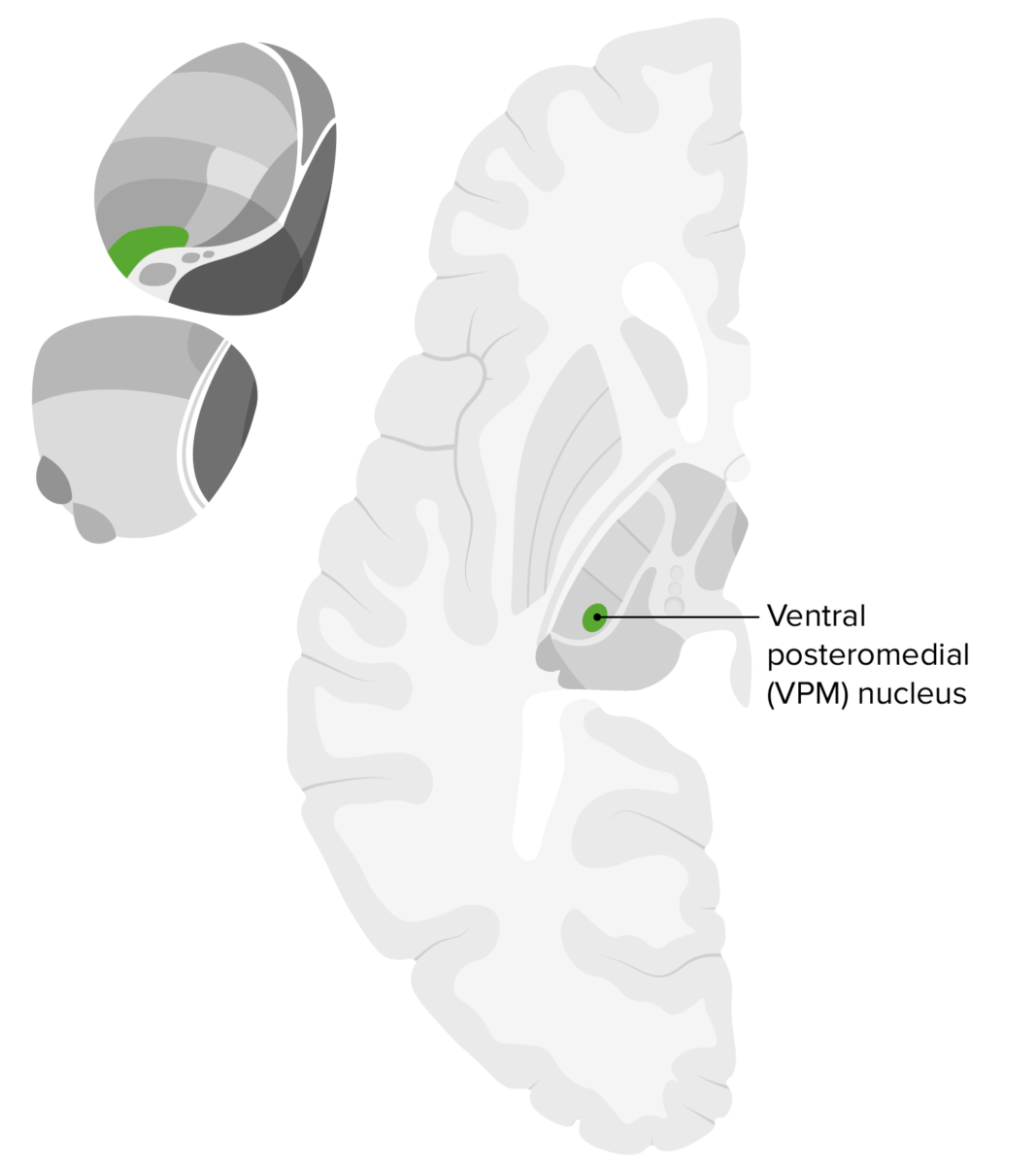
Location of the VPM thalamic nucleus
Image by Lecturio.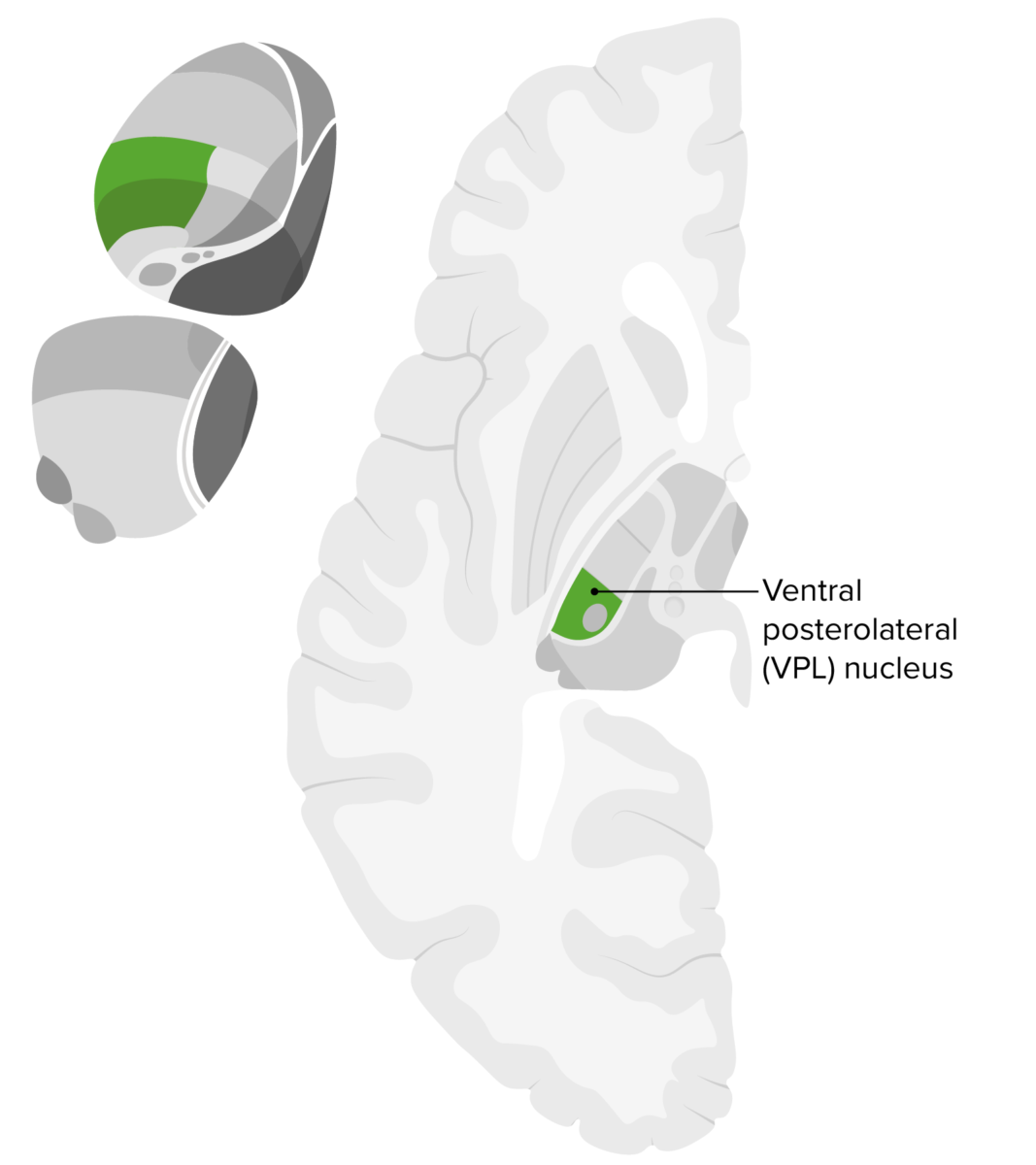
Location of the VPL thalamic nucleus
Image by Lecturio.The ventral anterior and ventral lateral nuclei are associated with inputs from the basal ganglia Basal Ganglia Basal ganglia are a group of subcortical nuclear agglomerations involved in movement, and are located deep to the cerebral hemispheres. Basal ganglia include the striatum (caudate nucleus and putamen), globus pallidus, substantia nigra, and subthalamic nucleus. Basal Ganglia: Anatomy and cerebellum Cerebellum The cerebellum, Latin for “little brain,” is located in the posterior cranial fossa, dorsal to the pons and midbrain, and its principal role is in the coordination of movements. The cerebellum consists of 3 lobes on either side of its 2 hemispheres and is connected in the middle by the vermis. Cerebellum: Anatomy and output to the frontal lobe Frontal lobe The part of the cerebral hemisphere anterior to the central sulcus, and anterior and superior to the lateral sulcus. Cerebral Cortex: Anatomy. Both nuclei are also associated with various motor pathways Motor pathways Spinal Cord: Anatomy.
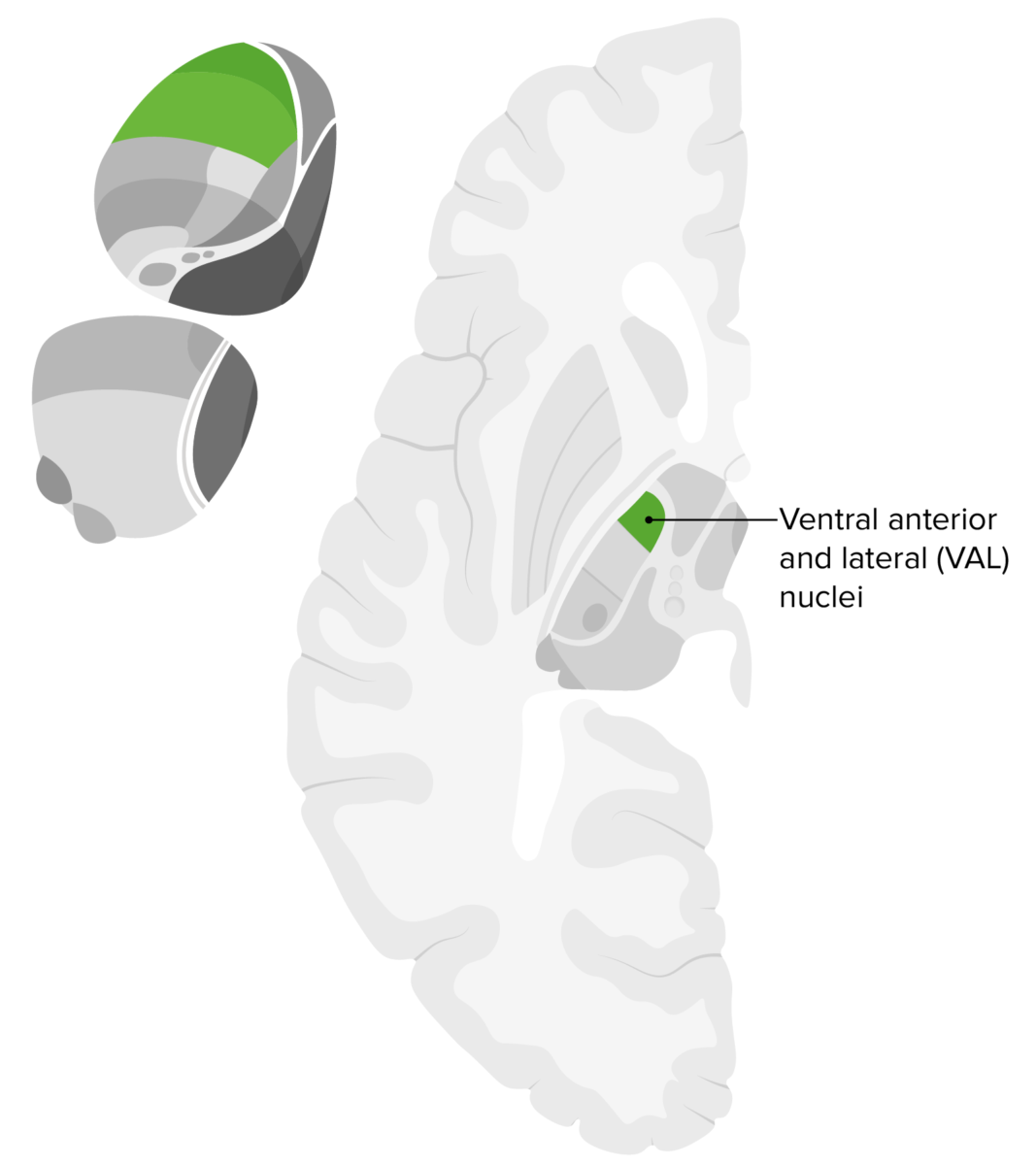
Location of the ventral anterior and ventral lateral nuclei
Image by Lecturio.The dorsomedial nuclei are associated with inputs from the amygdala Amygdala Almond-shaped group of basal nuclei anterior to the inferior horn of the lateral ventricle of the temporal lobe. The amygdala is part of the limbic system. Limbic System: Anatomy, olfactory centers, and basal ganglia Basal Ganglia Basal ganglia are a group of subcortical nuclear agglomerations involved in movement, and are located deep to the cerebral hemispheres. Basal ganglia include the striatum (caudate nucleus and putamen), globus pallidus, substantia nigra, and subthalamic nucleus. Basal Ganglia: Anatomy and output to the frontal Frontal The bone that forms the frontal aspect of the skull. Its flat part forms the forehead, articulating inferiorly with the nasal bone and the cheek bone on each side of the face. Skull: Anatomy cortex. The dorsomedial nuclei are associated with various limbic pathways.
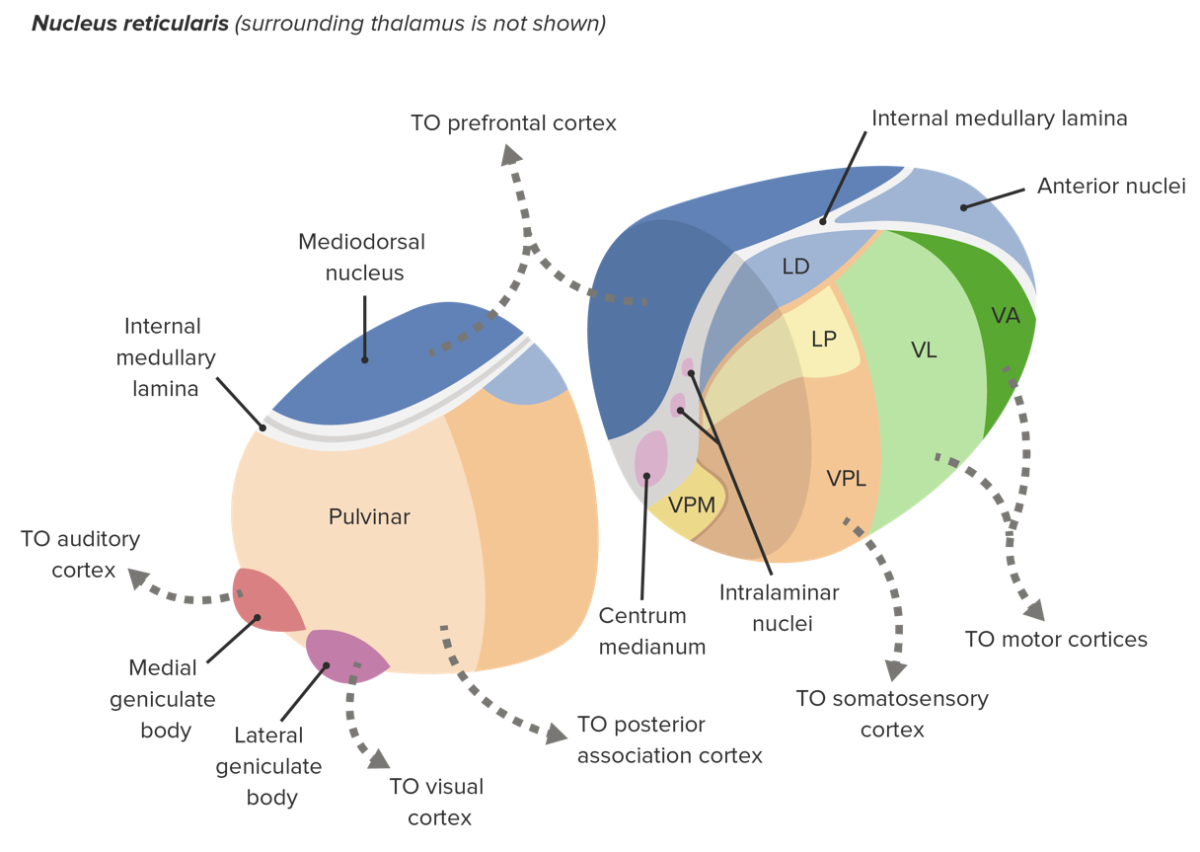
Nuclei that make up the thalamus and their respective projections: Note the dorsomedial (mediodorsal) nucleus located medially on the dorsal aspect of the thalamus with projections to the prefrontal cortex.
VA: ventral anterior
VL: ventral lateral
VPL: ventral posterolateral
VPM: ventral posteromedial
LD: lateral dorsal
LP: lateral posterior
The pulvinar is associated with inputs from the superior colliculus Superior Colliculus The anterior pair of the quadrigeminal bodies which coordinate the general behavioral orienting responses to visual stimuli, such as whole-body turning, and reaching. Cranial Nerve Palsies, visual areas, auditory complex, and other sensory pathways Sensory pathways Spinal Cord: Anatomy, and outputs to the parietotemporal association areas. The pulvinar is associated with various visual and sensory pathways Sensory pathways Spinal Cord: Anatomy.
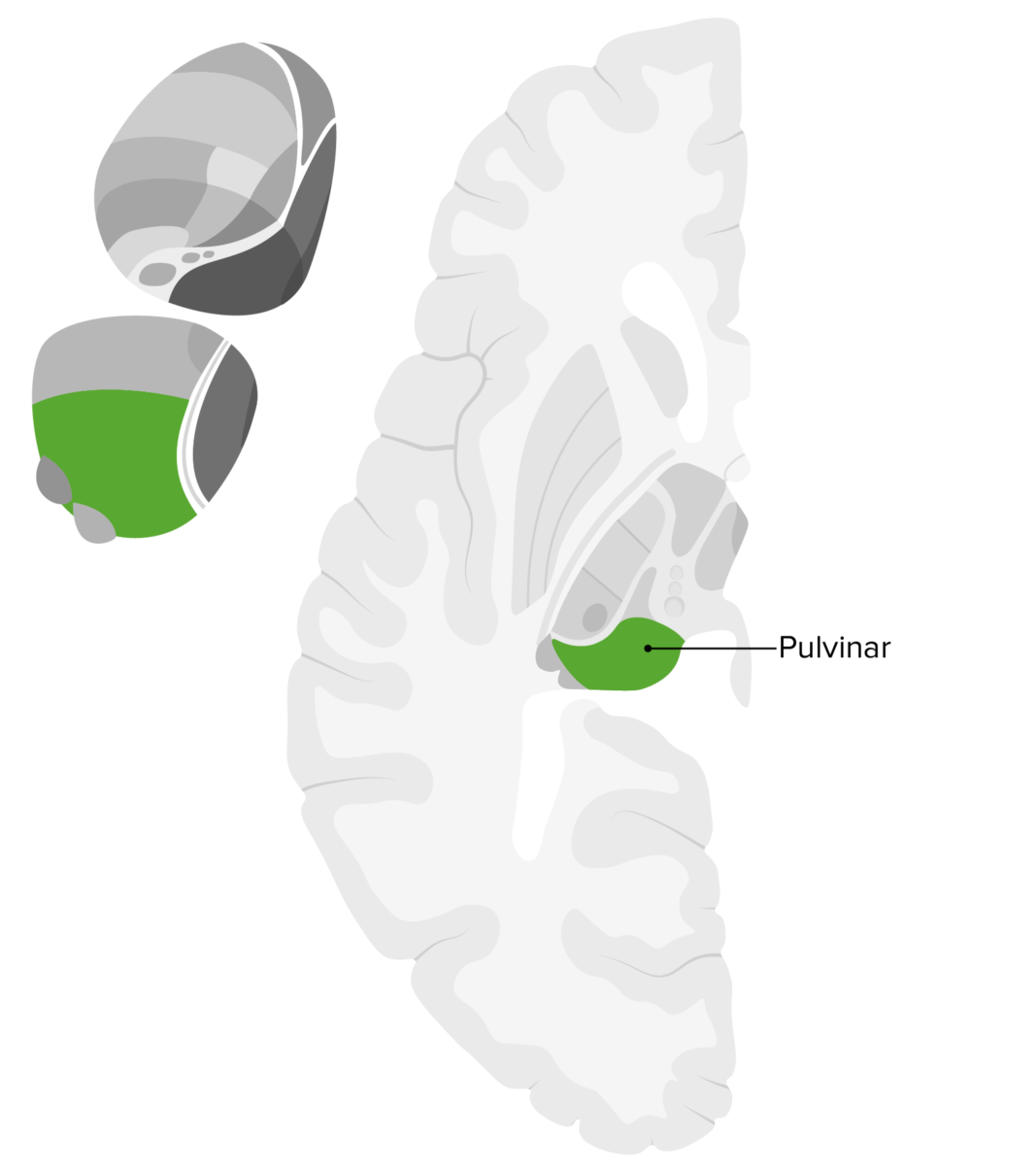
Location of the pulvinar, which is the posterior expansion of the thalamus overhanging the superior colliculus
Image by Lecturio.The medial and lateral geniculate bodies are associated with inputs from the inferior colliculus Inferior colliculus The posterior pair of the quadrigeminal bodies which contain centers for auditory function. Brain Stem: Anatomy and retina Retina The ten-layered nervous tissue membrane of the eye. It is continuous with the optic nerve and receives images of external objects and transmits visual impulses to the brain. Its outer surface is in contact with the choroid and the inner surface with the vitreous body. The outermost layer is pigmented, whereas the inner nine layers are transparent. Eye: Anatomy and outputs to the temporal lobe Temporal lobe Lower lateral part of the cerebral hemisphere responsible for auditory, olfactory, and semantic processing. It is located inferior to the lateral fissure and anterior to the occipital lobe. Cerebral Cortex: Anatomy and visual cortex Visual cortex Area of the occipital lobe concerned with the processing of visual information relayed via visual pathways. Cerebral Cortex: Anatomy, and are involved in various auditory and visual pathways.
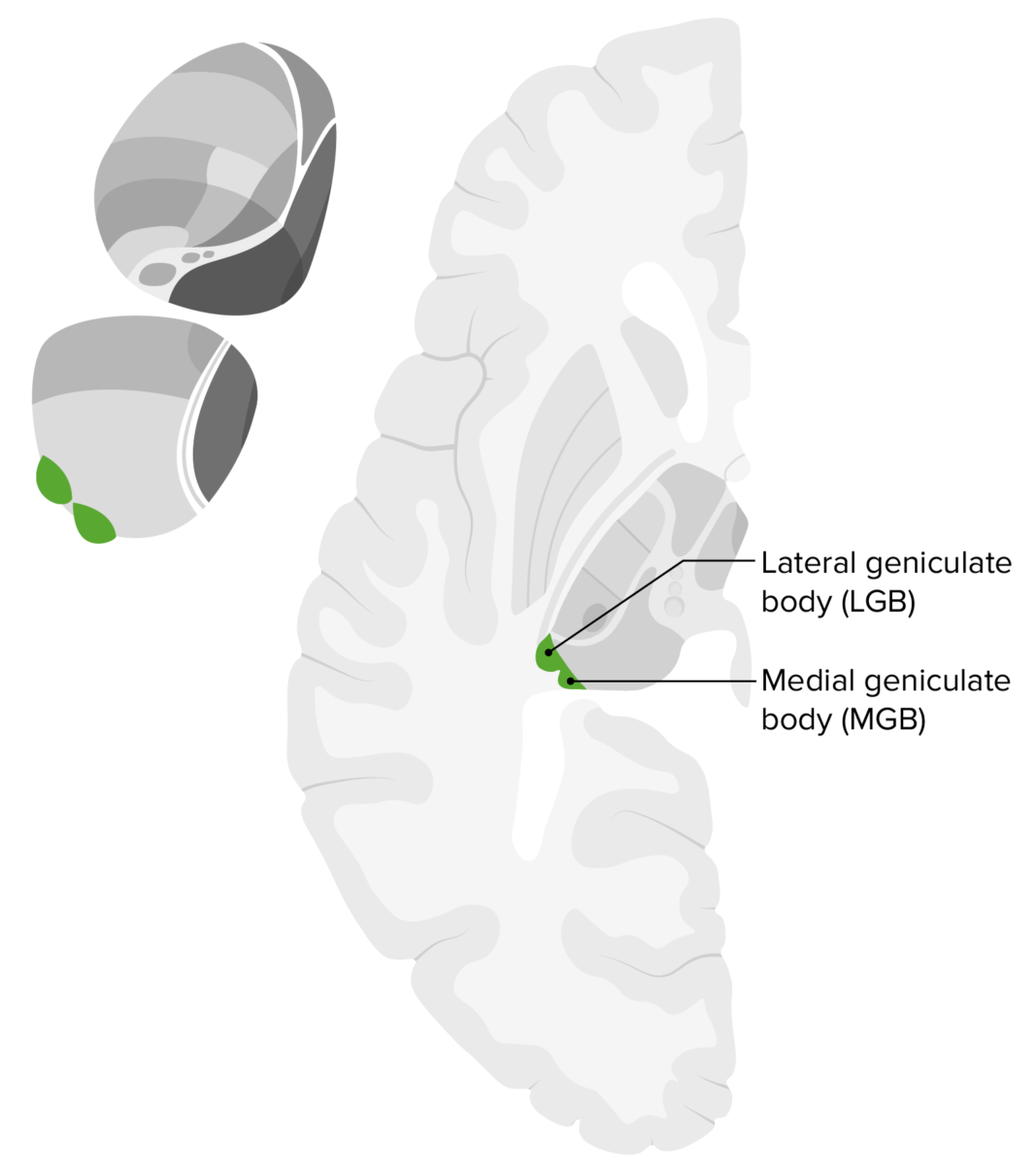
Location of the LGB and MGB of the thalamus
Image by Lecturio.Intralaminar and midline nuclei are associated with inputs from the spinal cord Spinal cord The spinal cord is the major conduction pathway connecting the brain to the body; it is part of the CNS. In cross section, the spinal cord is divided into an H-shaped area of gray matter (consisting of synapsing neuronal cell bodies) and a surrounding area of white matter (consisting of ascending and descending tracts of myelinated axons). Spinal Cord: Anatomy, hypothalamus Hypothalamus The hypothalamus is a collection of various nuclei within the diencephalon in the center of the brain. The hypothalamus plays a vital role in endocrine regulation as the primary regulator of the pituitary gland, and it is the major point of integration between the central nervous and endocrine systems. Hypothalamus, and descending reticular formation Reticular Formation A region extending from the pons and medulla oblongata through the mesencephalon, characterized by a diversity of neurons of various sizes and shapes, arranged in different aggregations and enmeshed in a complicated fiber network. Brain Stem: Anatomy, and outputs to the basal ganglia Basal Ganglia Basal ganglia are a group of subcortical nuclear agglomerations involved in movement, and are located deep to the cerebral hemispheres. Basal ganglia include the striatum (caudate nucleus and putamen), globus pallidus, substantia nigra, and subthalamic nucleus. Basal Ganglia: Anatomy and limbic system Limbic system The limbic system is a neuronal network that mediates emotion and motivation, while also playing a role in learning and memory. The extended neural network is vital to numerous basic psychological functions and plays an invaluable role in processing and responding to environmental stimuli. Limbic System: Anatomy. Both nuclei are associated with various emotional and sensory pathways Sensory pathways Spinal Cord: Anatomy.
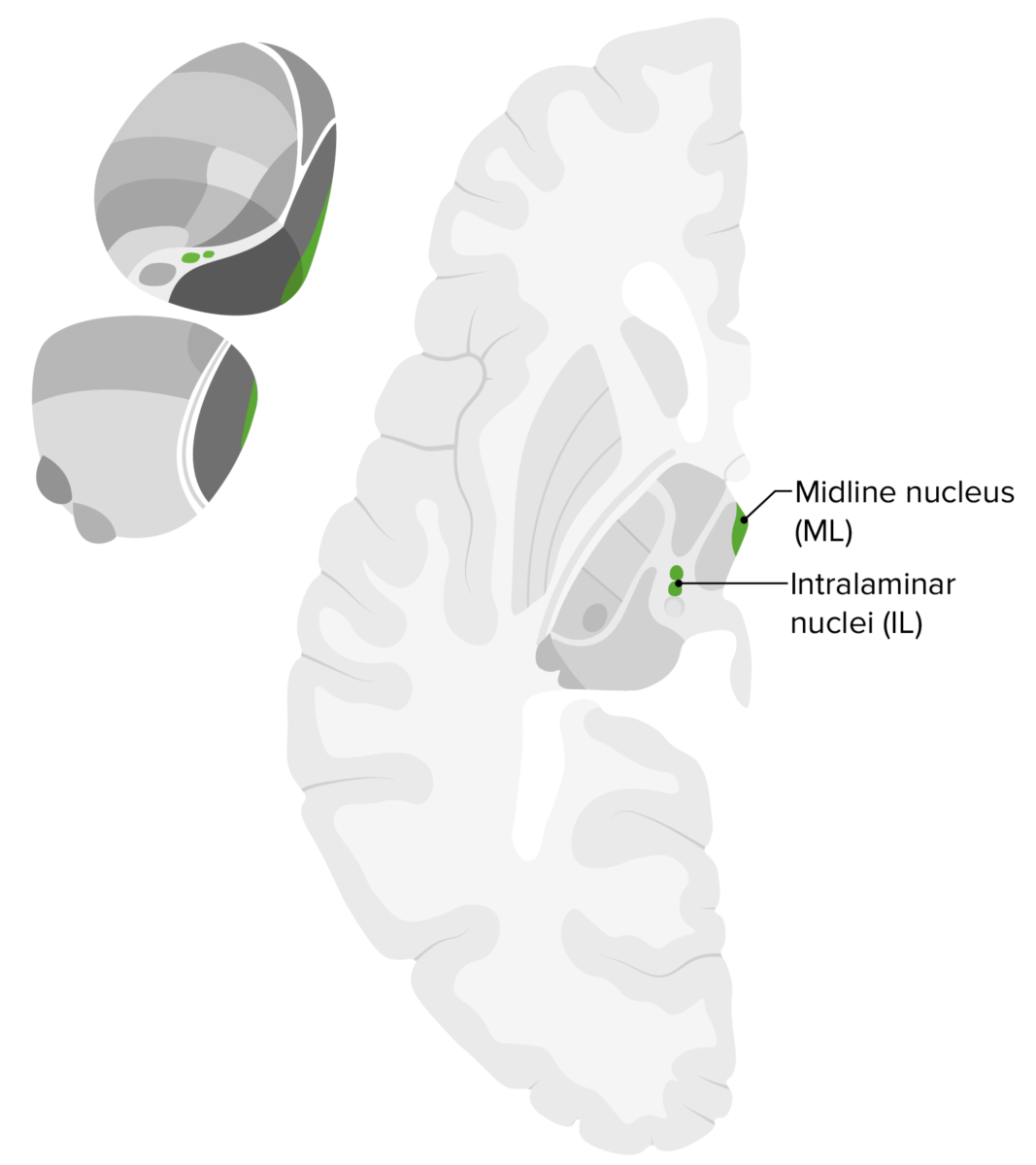
Location of the intralaminar/midline nuclei within the thalamus
Image by Lecturio.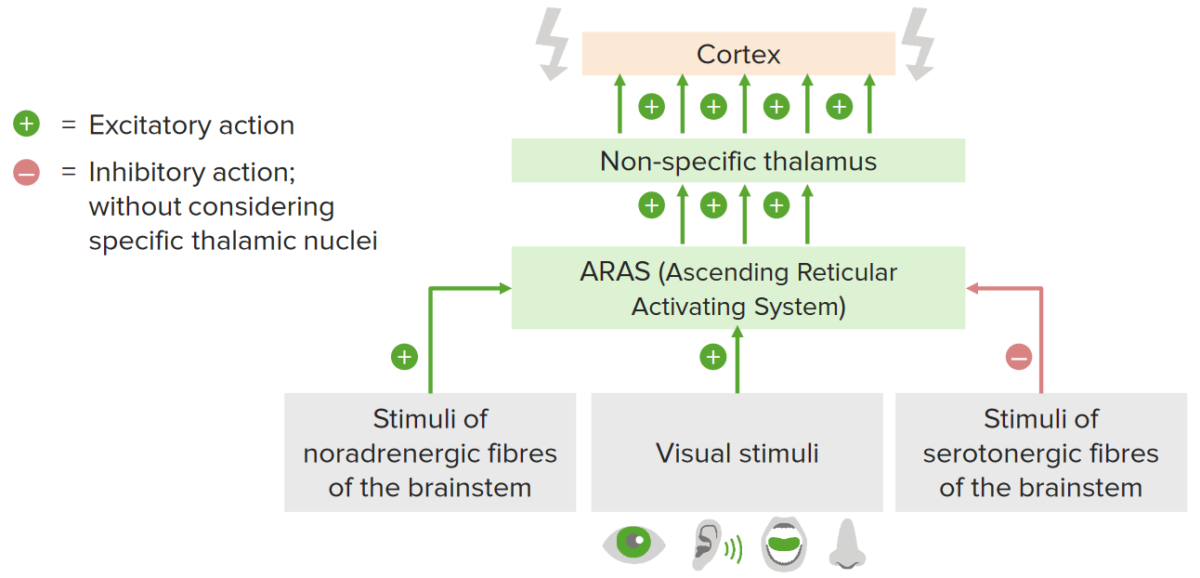
Effects of the ARAS: Sensory inputs (visual, auditory, olfaction, and gustation) leading to activation of the ARAS, which has its nuclei in the brainstem, are seen. In turn, the ARAS sends excitatory outputs to thalamic tissue. The thalamus relays this excitation to the cortex, resulting in activation.
Image by Lecturio.